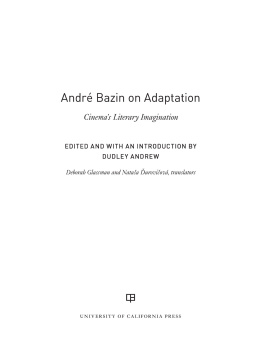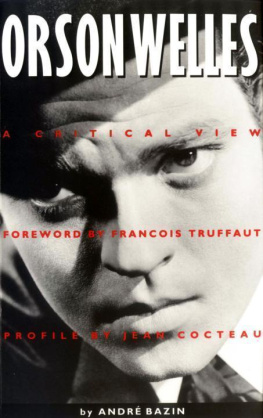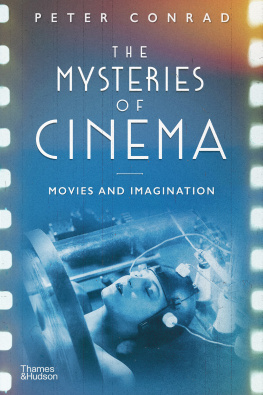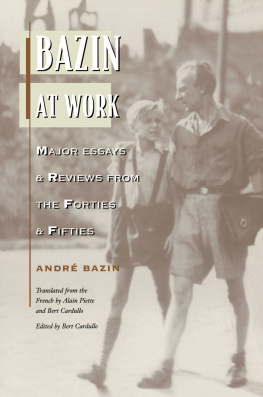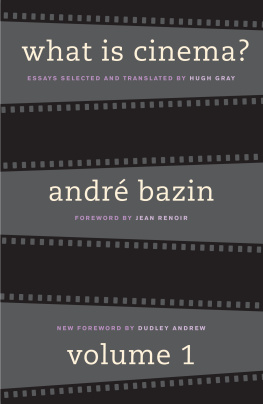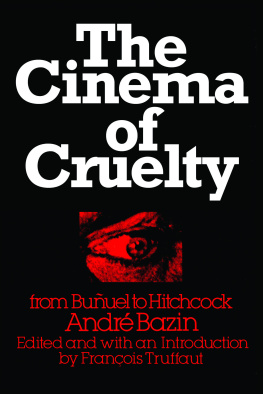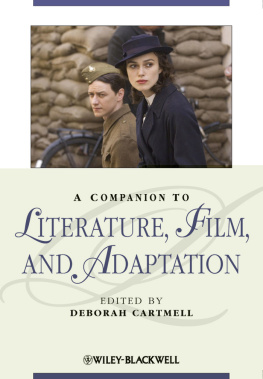The publisher and the University of California Press Foundation gratefully acknowledge the generous support of the Robert and Meryl Selig Endowment Fund in Film Studies, established in memory of Robert W. Selig.
Andr Bazin on Adaptation
Cinemas Literary Imagination
EDITED AND WITH AN INTRODUCTION BY DUDLEY ANDREW
Deborah Glassman and Nataa uroviov, translators

UNIVERSITY OF CALIFORNIA PRESS

University of California Press
Oakland, California
2022 by The Regents of the University of California
Excerpted from crits complets , Andr Bazin (author), Herv Joubert-Laurencin (editor), 2018 ditions Macula.
Library of Congress Cataloging-in-Publication Data
Names: Andrew, Dudley, 1945- editor, writer of introduction. | Glassman,
Deborah, translator. | uroviov, Natasa, translator.
Title: Andr Bazin on adaptation : cinemas literary imagination / edited and with an introduction by Dudley Andrew ; Deborah Glassman and Nataa uroviov, translators.
Description: Oakland, California : University of California Press, [2022] | Includes index.
Identifiers: LCCN 2021032897 (print) | LCCN 2021032898 (ebook) | ISBN 9780520375802 (cloth) | ISBN 9780520375819 (paperback) | ISBN 9780520976252 (ebook)
Subjects: LCSH : Bazin, Andr, 19181958. | Film adaptationsHistory and criticism. | Motion picturesFranceHistory and criticism.
Classification: LCC PN 1998.3. B 39 A 53 2022 (print) | LCC PN 1998.3. B 39 (ebook) | DDC 791.43/6dc23
LC record available at https://lccn.loc.gov/2021032897
LC ebook record available at https://lccn.loc.gov/2021032898
31 30 29 28 27 26 25 24 23 22
10 9 8 7 6 5 4 3 2 1
Contents
Preface
In 1967, thousands of us Anglophone film enthusiasts were knocked sideways when the University of California Press brought out a slim pink volume, Andre Bazins What is Cinema? The sixty-plus articles gathered here pursue that rapport across his career.
Cinemas literary imagination, as I call it, naturally coalesces around the question and practice of adaptation. My introduction describes how Bazins sensitivity to this cinematic realm grew into carefully formulated theoretical reflections, but only after he had reacted to a great many types of adaptation. Although literature has always funded cinema, Bazin started out as a twenty-six-year-old critic at a particularly rich moment, for in Autumn 1944 a phalanx of Hollywood films began pouring into Paris behind the liberating G.I.s. One of the first pieces he published noted that among these were an inordinate number of adaptations of currently prominent authors, some of whom (William Faulkner, Ernest Hemingway) were even active in the film industry. He inevitably compared Hollywoods approach to adaptation to that of France, where, during the Occupation, the stately Cinema of Quality had taken root very much under the sway of the nineteenth-century novels it so often used as sources. About half of my selections precede 1950, a year of hiatus and ill health for Bazin that he used to deepen his reflections on what today we call comparative arts and prepare the core articles mentioned above. This was also just when he co-founded Cahiers du cinma and immediately upped the stakes on the question of adaptation with his article on Bressons Journal dun cur de campagne. That remarkable instance made him even more vigilant in monitoring adaptations, for he was convinced that cinema could greatly mature in such interaction, even though he realized that most adaptations are reactive, if not reactionary, with producers literally banking on the reputation of famous novels.
Film producers are even more likely to rely on well-known plays, as these have already been broken down into scenes with dialogue and settings that can be conveniently taken whole or modified. Moreover, plays have been tested in front of an audience. Bazin penned scores of reviews dealing with films adapted from plays and devoted his lengthiest essay to the theater-cinema rapport. But the questions he posed there, involving issues of acting, space, architecture, and the co-presence of players and audience, are sufficiently distinct that I have sidelined them for the moment, hoping later to edit a companion to this volume. Thus, literature here refers mainly to prose fiction; in this context, Bazin routinely thought about cinema through narrative categories such as image, voice, tense, narration, interiority, and description. Sharing these categories, the two art formsto use his analogypass the baton back and forth in a cultural relay race, with cinema starting later but running faster. In mid-century, Bazin believed these were unquestionably the most consequential art forms, attracting both popular and highly educated audiences, the way theater had done in Elizabethan England, or as poetry has done for centuries in Persia.
And so when writing about films that evoke literature, Bazin could expect a large and diverse readership. This anthology provides many examples of the criticism he produced several times a week for Pariss most popular newspaper, Le Parisien libr, and regularly for the more urbane weeklies LObservateur and Radio-Cinma-Tlvision , and the monthlies Esprit and Cahiers du cinma. You will also find a piece he wrote for a university broadside and one for the publicity rag of the film industry, as well as a couple for sophisticated literary journals. Remarkably, his views seem consistent over the course of fifteen years; they also seem consistently pitched to the intelligence and imagination of his readers no matter their background, although one can hear him inflect his style as he switched from one assignment and periodical to another. For he frequently reviewed the same film two or three and occasionally four times, without, mind you, repeating many of the same phrases or points. Ive selected two reviews each for three of the adaptations in this collection, to enable not just a binocular look at his ideas but a chance to watch his prose adjust itself ever so slightly to fit the venue.
Bazin did not imagine anyone would read his ideas about a film in more than one periodical. And he certainly had no expectation that these reviews would be passed down for later generations to examine. His preface to Quest-ce que le cinma?, written days before his death, exudes modesty:
Of the mass of pages my pencil has blackened day after day, most are good only for lighting a fire; some may have had a bit of value in terms of the state of the current cinema when they came out but scarcely have any retrospective interest today. I eliminated them because the history of criticism is in itself a minor thing, and a specific review or critique (of a film) interests nobody, not even the critic himself, except as an exercise in humility.
That winnowing process left him, he continued, the sixty-four articles that he did find worth preserving, including the seven that form volume two of Quest-ce que le cinma?. However, for once, Bazins judgment was off. As I bring back reviews that he turned out overnight or in the course of a busy weekreviews, in some cases, about films that are forgotten and difficult to locate todayeach seems precious. In aggregate, these sixty-two articles clarify the history, achievements, and possibilities of the two art forms he rightly took to be the most significant of the century. They also illuminate a writer of dazzling intelligence as they trace an unbroken, sinuous line of thought from first to last.

